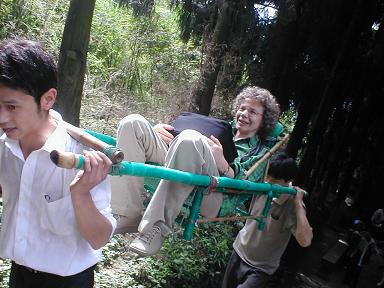
(Just to explain, I’ve been back from China for a couple of weeks now, but still have blog posts to make about it, which I’m gradually catching up on)
When we were in Chengdu we went on a trip a couple of hours south to Emei Shan. This is where the religious thread of the holiday met the family history one.
My grandmother went on a journey up the Yangtze river to Emei Shan in 1936, with her friend Gracie. She’d been in Shanghai for six years, and in her summer holidays had already visited Peking, the Philippines, Saigon, Angkor, Bangkok, Korea and Japan. So by 1936 there wasn’t much left – they had to go to inland China. At the time, this was a very adventurous thing for two unaccompanied English ladies to do.
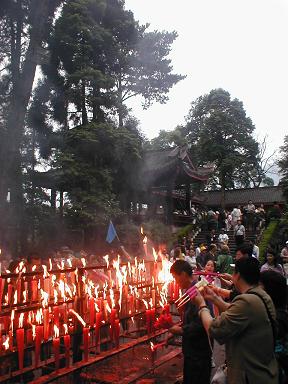 This verdant mountain is an ancient place of pilgrimage, both for pious Buddhists, and for seemingly millions of Chinese tourists. But as soon as you take a hard route away from the temples near the road, it becomes quiet and calm, you can watch the dragon flies, and be at peace.
This verdant mountain is an ancient place of pilgrimage, both for pious Buddhists, and for seemingly millions of Chinese tourists. But as soon as you take a hard route away from the temples near the road, it becomes quiet and calm, you can watch the dragon flies, and be at peace.
We walked up the long route, but only went half way up. Even so it was very steep, so for some sections Rosemary got herself carried (photo). This was following her mother – who went up the mountain carried by 7 men! “3 to carry me – 2 Gracie and 2 baggage”
We stayed the night on the mountain in a Buddhist temple, in a surprisingly luxurious room. I’d hope for something a bit more down with the monks (I’d accidentally been to a service with some at the monastry in the town at the bottom of the mountain the night before), but Rosemary needed as much luxury as we could find. It was peaceful wondering round the glen in the twilight, with lakes and bridges. I went up onto the roof garden, watched and briefly played cards with a monk and some of the lay workers.
On the way back down (via foot, cable car and bus) in the morning we saw two donkeys struggling their way up the steps from the valley below. They were both loaded with panniers containing fine rocks for building. Panting all the time, they would sometimes stumble. Their two minders had spades, which I saw one beat his donkey with when it had fallen down once too often.
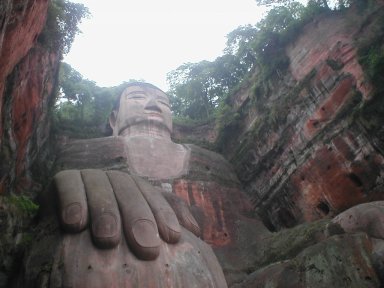
That afternoon we went to see the largest Buddha in the world as Leshan, carved in a rockface by the river. I climbed down the steps to his feet, and looked up in awe (photo). The Chinese tourists hardly looked, as ever busy snapping souvenir photos of themselves in front of him. I put my camera away. I thought about impermanence. He looked down at me and told me that life is change, and that I would never see him again. In the end, that’s the way it is with everything in this fragile world.
And my grandmother? She stayed five days at the top of the mountain, sleeping in a temple on their own camp beds, and eating tinned beans and pork they’d brought with them. The weather completely failed to clear, so she never saw the rarely visible fantastic view, and had to set off on the weeks of journey home.
She never mentioned the Leshan Buddha in her letters, even though her boat must have gone past it. This had puzzled my mother. But now we know. It is actually quite hard to see the Buddha from the river, you’d have to happen to look when the boat was right next to him.
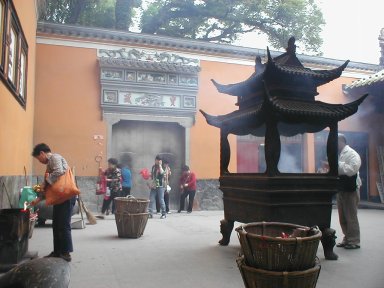 Even though I’m an atheist, it’s fun and moving to seek out pious people and watching them going about their business. A few years ago I used to do this in the UK via
Even though I’m an atheist, it’s fun and moving to seek out pious people and watching them going about their business. A few years ago I used to do this in the UK via 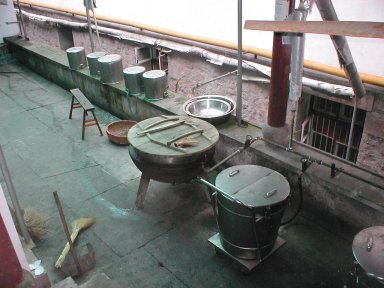 As well as Chinese pilgrims, there were also lots of Chinese tourists, most of whom we found in the morning down by the coast, coming to look at the brand new (well, 1998) shiny statue of Guanyin. She is golden, holding a small ships wheel in one hand to bring luck to fisherman. She towers what must be 30m above you, you climb up steps to her, flanked by guardians. She rests on a tower of two halls, on a promontry with almost 360 degree views of the sea. One hall contains amazing detailed wood carvings, and another 400 statues of her past lives. A stone carving frieze encircles the halls, skillfully carved with scenes of Guanyin helping locals. I’ve seen quite a few spectacular Buddhist statues, and this one was pretty good. Not to be diminished because she was new, she was awesome.
As well as Chinese pilgrims, there were also lots of Chinese tourists, most of whom we found in the morning down by the coast, coming to look at the brand new (well, 1998) shiny statue of Guanyin. She is golden, holding a small ships wheel in one hand to bring luck to fisherman. She towers what must be 30m above you, you climb up steps to her, flanked by guardians. She rests on a tower of two halls, on a promontry with almost 360 degree views of the sea. One hall contains amazing detailed wood carvings, and another 400 statues of her past lives. A stone carving frieze encircles the halls, skillfully carved with scenes of Guanyin helping locals. I’ve seen quite a few spectacular Buddhist statues, and this one was pretty good. Not to be diminished because she was new, she was awesome.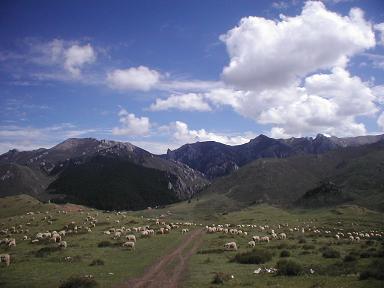 Tibetan sky burials sound very odd, exotic, macabre. After being shown a sky burial ground by a native who takes part in them, my mind began to twist round and see them as normal. Just as many Tibetans do – I don’t know figures, but it is widespread. A sky burial goes like this.
Tibetan sky burials sound very odd, exotic, macabre. After being shown a sky burial ground by a native who takes part in them, my mind began to twist round and see them as normal. Just as many Tibetans do – I don’t know figures, but it is widespread. A sky burial goes like this.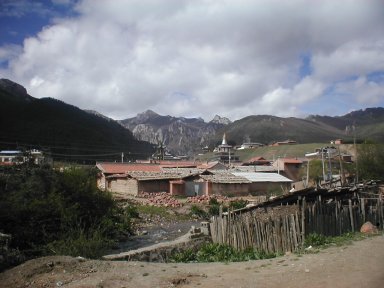 Two interesting things. Her first language was the Amdo dialect of Tibetan, but she was only taught to read and write in Chinese at school. Now, in her mid 20s, she was finally starting to learn the Tibetan alphabet.
Two interesting things. Her first language was the Amdo dialect of Tibetan, but she was only taught to read and write in Chinese at school. Now, in her mid 20s, she was finally starting to learn the Tibetan alphabet. 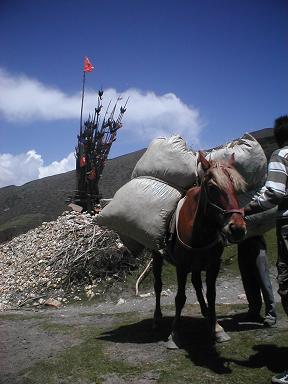 At the moment I’m in Tibet.
At the moment I’m in Tibet.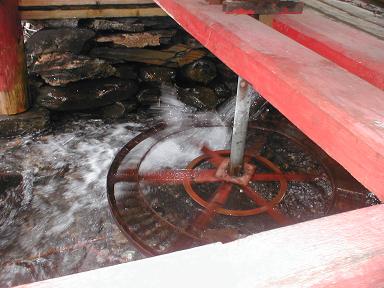
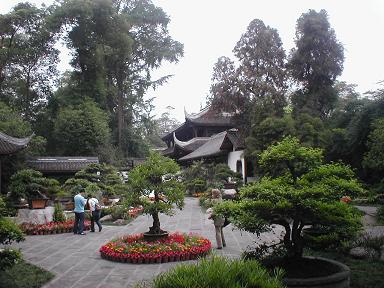 If you fall off the eastern edge of the Himalayan mountains, the first major city (population 4.1 million) that you come to is Chengdu, in China’s Sichuan province. You’ve heard of it from the spicy Chinese food, called “Szechuan” in the west.
If you fall off the eastern edge of the Himalayan mountains, the first major city (population 4.1 million) that you come to is Chengdu, in China’s Sichuan province. You’ve heard of it from the spicy Chinese food, called “Szechuan” in the west.